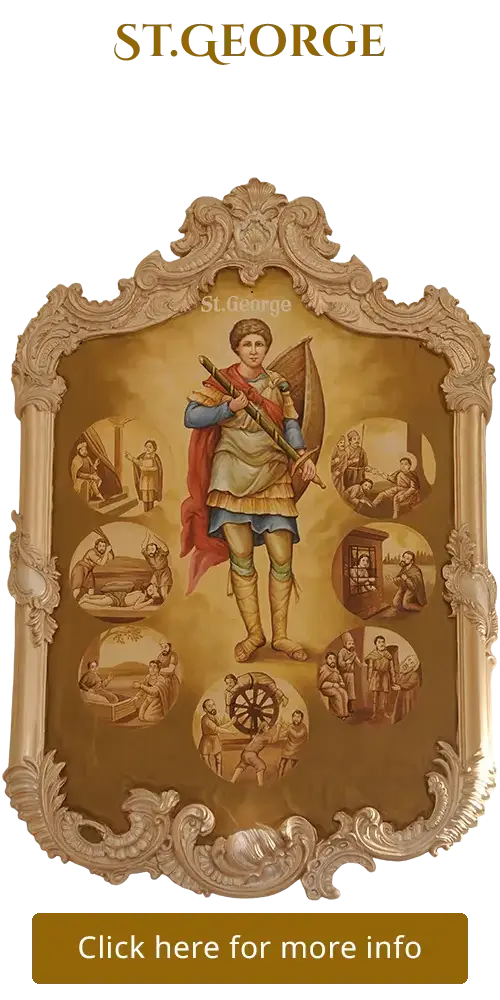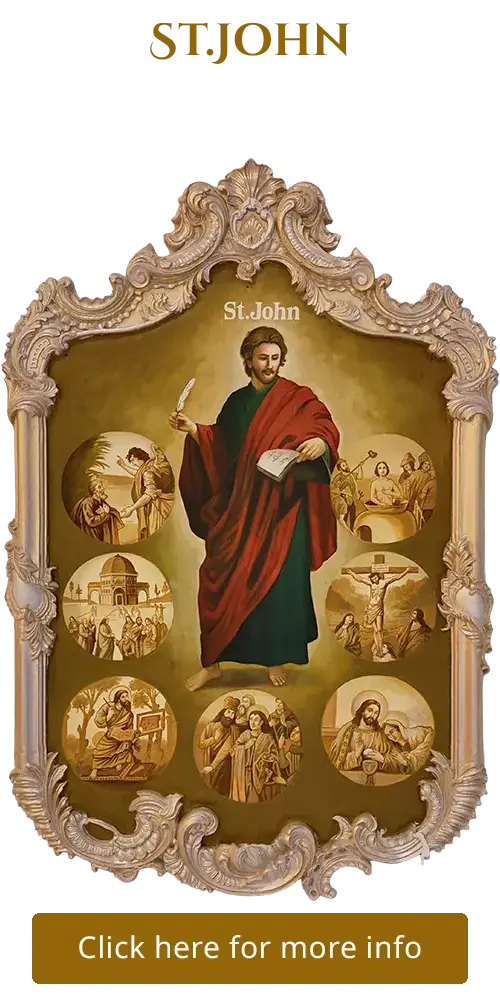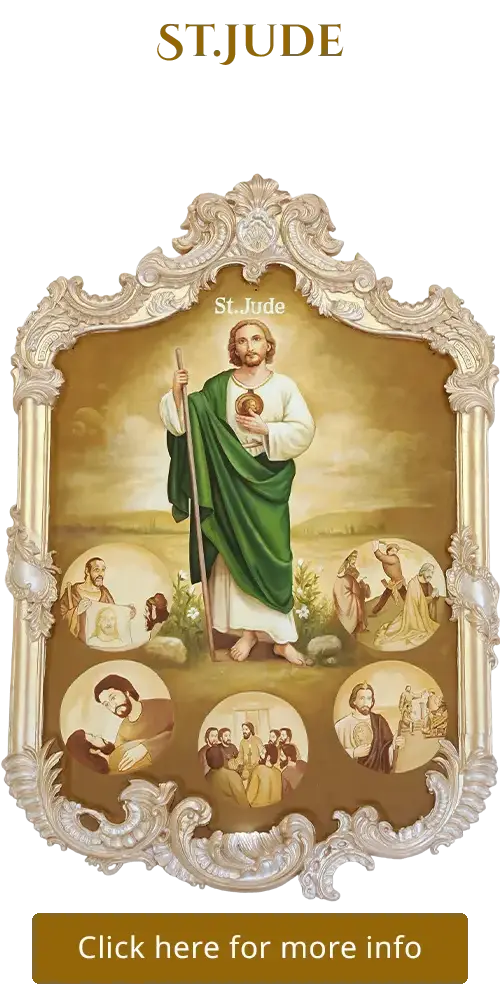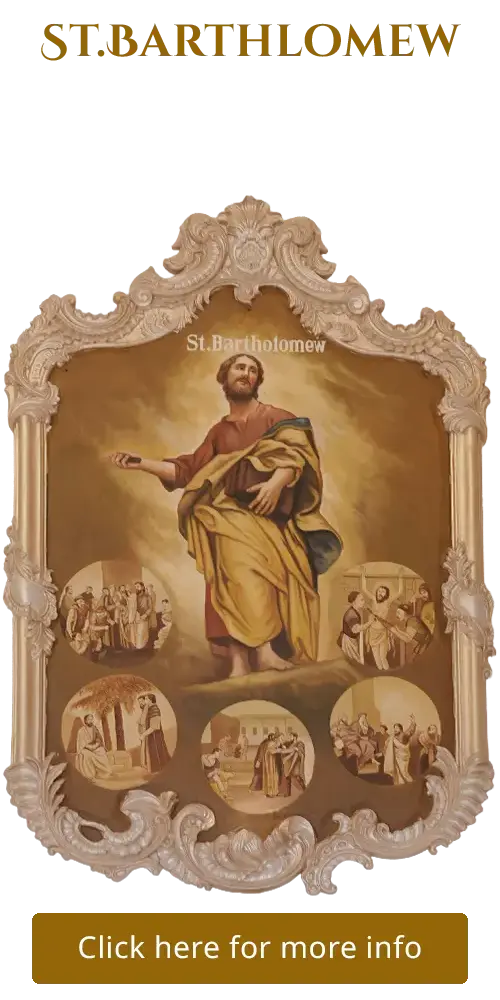St. Simon
Inside Paintings - South Wall
St. Simon
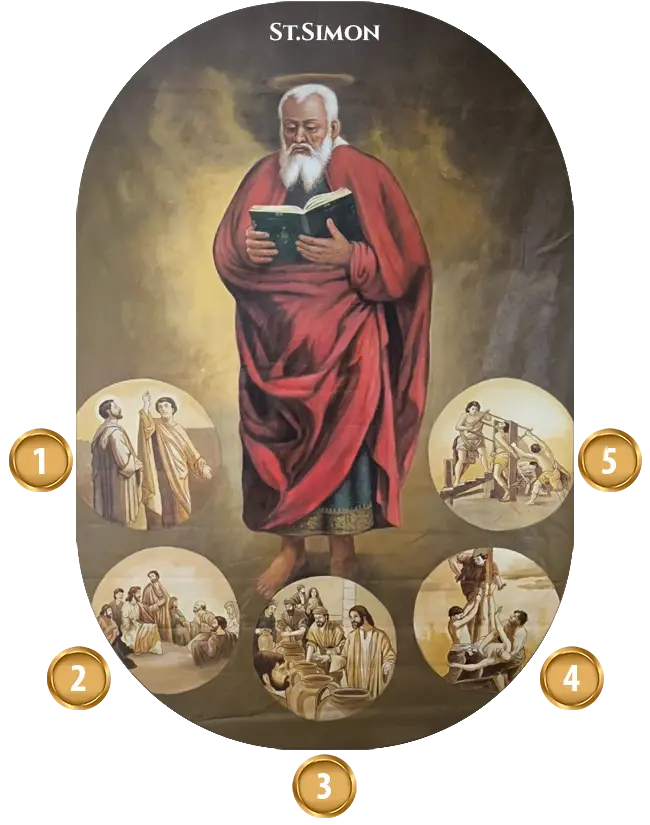


1. Joint Ministry with St Jude Thaddaeus
Historical Reference: Roman Martyrology, Golden Legend.
Description:
St. Simon, also called Simon the Canaanite or Zealot, traveled through Egypt preaching the Gospel, while St. Jude (Thaddaeus), identified as the brother of James and author of the Epistle of Jude, evangelized in Mesopotamia. According to tradition, the two apostles later united in Persia, where they converted many to Christianity, spreading the faith among hostile pagans. Through their preaching, miracles, and eventual martyrdom, they glorified the name of Jesus Christ, leaving a lasting legacy in the early Church. Later traditions suggest they evangelized together in the East (Persia, Armenia, or even Lebanon) before their martyrdom.
Western Christianity celebrates Simon and Jude together on October 28th, a date that contributes to the association of the two apostles in tradition.
2. St. Simon’s Healing and Call by Jesus
Historical Reference: Traditions and Early Christian writings
Description: In a quiet, sunlit village on the outskirts of Galilee, a young boy named Simon – later known as the Zealot – faced a life-threatening moment that would shape his destiny. It was a warm afternoon, perhaps in the early years of Jesus’ ministry around 27-28 AD, when Simon, full of youthful energy, wandered near a rocky outcrop dotted with wild shrubs. Unbeknownst to him, a venomous snake lay coiled in the shadows. As he reached to explore, the snake struck, its fangs sinking deep into his small hand. A sharp pain shot through him, and within moments, the bite swelled, turning his skin red and causing him to stagger. His cries pierced the air as he collapsed, his life ebbing as the poison spread.
Nearby, a compassionate figure approached – Jesus of Nazareth, who was traveling through the region, teaching and healing. Hearing Simon’s distress, Jesus hastened to his side, His presence calm yet commanding. Kneeling beside the trembling boy, Jesus gently took Simon’s injured hand in His own. With a voice filled with authority and love, He prayed, calling upon the power of God to heal. As He spoke, a warmth radiated from His touch, and the swelling began to recede. The redness faded, the pain vanished, and Simon’s breathing steadied. In moments, he sat up, whole and restored, his wide eyes fixed on the man who had saved him.
Moved by this miracle, Simon gazed at Jesus, who looked back with a gentle smile. In that sacred moment, Jesus placed a hand on the boy’s shoulder and said, “You will grow to be one of my disciples.” The words carried a prophetic weight, planting a seed of faith in Simon’s heart. This encounter, preserved in early Christian oral tradition, marked the beginning of Simon’s journey from a village child to an apostle. Years later, this call was fulfilled when Jesus summoned him from his life as a Zealot to join the twelve (Matthew 10:4), a transformation rooted in that day of healing.
3. In the event of wedding at Cana
Historical Reference: John 2:1-11
Description: In the quiet village of Cana in Galilee, a joyous wedding celebration unfolded one sunny afternoon, traditionally dated to the early days of Jesus’ ministry, around 30 AD. The bridegroom, according to a cherished early Christian tradition, was St. Simon the Zealot, a local man known for his fiery spirit and later called to be one of Jesus’ twelve apostles. The occasion was vibrant, with music, laughter, and the clinking of cups as guests, including family and friends, gathered to honor the union. Among the invited were Mary, the mother of Jesus, and her son, along with His disciples, who included Simon himself, though at this point, he was still a host rather than a follower.
The festivities were in full swing when a quiet concern arose – the wine, the lifeblood of the celebration, had run dry. In a culture where hospitality was sacred, this could bring shame upon the bridegroom’s household. Mary, ever attentive, noticed the predicament and approached Jesus, saying simply, “They have no wine” (John 2:3). Jesus, though initially responding that His hour had not yet come, responded to His mother’s gentle prompting. Nearby stood six stone water jars, each holding twenty to thirty gallons, used for Jewish purification rites. At Jesus’ command, the servants filled them to the brim with water. He then instructed them to draw some out and take it to the master of the feast.
As the servants obeyed, the water transformed into wine of exceptional quality. The master of the feast, tasting it, called the bridegroom – Simon – over in amazement, exclaiming, “Everyone serves the good wine first, and when people have drunk freely, then the poor wine. But you have kept the good wine until now” (John 2:10). Unaware of the miracle, Simon stood humbled and astonished, while the disciples, including those present, began to believe in Jesus’ divine power. This first public sign, as John records, revealed Jesus’ glory and marked a turning point for Simon, whose life as a bridegroom intersected with his calling to discipleship.
Tradition holds that this moment at his own wedding ignited Simon’s faith, setting him on a path from hosting a celebration to proclaiming the Gospel across regions like Persia and beyond. The miracle, witnessed by Simon and the others, foreshadowed the abundance of grace Christ would offer.
4. Healing the Sick and Casting Out Demons
Historical Reference: Early Church writings and apocryphal texts, such as the Acts of the Apostles and later hagiographies
Description: Following the Great Commission (Matthew 28:19-20), where Jesus instructed His disciples to “go and make disciples of all nations,” Simon embraced this call with the same fervour he once directed toward his earlier life as a Zealot seeking political liberation.
One detailed tradition places Simon in Samaria, a region steeped in spiritual need. As he entered a village, he encountered a crowd gathered around a man paralyzed for years, unable to move or care for himself. With a heart full of faith, Simon knelt beside him, laying hands on his frail body while praying fervently in Jesus’ name. Witnesses described a sudden warmth and strength flowing through the man, who rose to his feet, praising God as the villagers looked on in awe. Word of this miracle spread quickly, drawing others seeking help.
Among them was a woman tormented by a demon, her cries echoing through the streets as she struggled against an unseen force. Her family, desperate for relief, brought her to Simon. With calm authority, he confronted the evil spirit, commanding it to leave her in the name of Jesus Christ. The air grew tense as the demon resisted, but Simon’s steadfast prayer prevailed. The woman collapsed, then awoke peaceful and restored, her eyes clear and her voice steady. The onlookers, many of whom had followed pagan practices, fell to their knees, converted by the power they witnessed.
Simon’s ministry was marked by such acts, often performed in humble settings—marketplaces, homes, or open fields—where he preached the Gospel alongside his miracles. His hands, once raised in rebellion, now lifted in healing, and his voice, once calling for justice against Rome, now proclaimed liberation through Christ. Tradition holds that he faced opposition from local priests and rulers, yet his miracles continued, leading entire communities to faith before his eventual martyrdom.
5. Martyrdom
Historical Reference: Traditions like the Golden Legend
Description: On a solemn day around 65 AD, St. Simon the Zealot, one of Jesus’ twelve apostles, faced his martyrdom in Persia (modern-day Iran), a land where he had tirelessly preached the Gospel alongside St. Jude Thaddeus. Simon’s successful ministry stirred the wrath of pagan priests. His miracles – healing the sick and casting out demons – had won many converts, including some from the local elite, threatening the priests’ authority. Determined to silence him, they conspired with Roman officials to end his life.
The scene began in the heart of a crowded square in a Persian city, where a wooden frame was erected, its rough beams stark against the dusty ground. Simon, bound with coarse ropes, stood resolute, his face etched with faith rather than fear. The priests, clad in dark robes, ordered two burly executioners to carry out the sentence. These men, their muscles straining, lifted heavy saws, their blades glinting in the harsh sunlight. The crowd murmured, some in horror, others in anger, as the executioners positioned Simon against the frame, his arms and legs secured to bear the weight of what was to come.
With a signal from the priests, the sawing began. The executioners, one on each side, drove the jagged blades into Simon’s body, starting at his midsection. Blood began to flow, staining the wood and pooling on the ground below, a stark red against the earth. Simon’s voice rose above the sound of the saws, not with cries of pain but with prayers, calling on the name of Jesus Christ. His endurance amazed the onlookers, and an eerie stillness fell over the square as the executioners continued their grim task. Tradition holds that an earthquake trembled the ground, a sign of divine displeasure, causing some to flee in terror while others fell to their knees, converted by his steadfast witness.
As the blades cut deeper, Simon’s strength waned, yet his spirit remained unbroken. His sacrifice, believed to have occurred on a day now commemorated near October 28, left a legacy of courage. His relics were later venerated, with some transferred to St. Peter’s Basilica in Rome.

